The PS5 and Switch OLED are disappointments, so I’m glad I stuck with PC gaming this gen
The Steam Deck could sway me

I was ready to give Sony and Nintendo my money, I really was, but both the PS5 and recently-revealed Nintendo Switch OLED have left me unimpressed, further convincing me that the PC is by far the best platform to play on at the moment.
While I have been a PC gamer all my life – the Amiga A500+ was the first gaming device I ever owned, and the likes of Lemmings and Bart Simpson vs the Space Mutants are the reason I am a tech journalist today – I’ve also loved console gaming as well. I’ve owned every generation of PlayStation, so when the PS5 launched, I was well up for getting one.
I wasn’t the only one it seems, and the PS5 remains rarer than an honest politician. While unable to buy one, I realised that there were very few exclusives for the console I actually wanted – except Ratchet and Clank.
- US-only: PS5 restock tracker
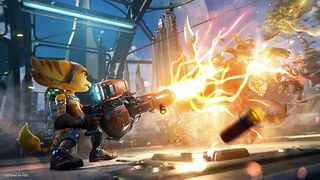
The other games either don’t really interest me enough to buy a new console, or are also available on the PS4, which I own. Some are also coming to PC, further dampening my enthusiasm to splurge on a new console at the moment.
It’s a similar story for the Nintendo Switch. That console has been around long enough to generate a nice library of games for it, and the fact it’s been relying on Wii U ports to bolster its first party library didn’t bother me too much as I never owned the original console.
However, I didn’t love the stories of poor graphics and bad performance on some titles, so when rumors started swirling that a more powerful version was coming, I started to get interested. I’ll be starting to commute back into the office, so an updated Switch that could play games at 1080p on my TV when I was at home, and offered better handheld performance when I was on a bus or a train, was certainly compelling.
As is so often the case with Nintendo rumors, though, the speculation was more exciting than the reality. Nintendo finally revealed it was indeed working on a new Switch model, but the Switch OLED would only come with an improved screen – the rest of the hardware would remain the same.
Get the best Black Friday deals direct to your inbox, plus news, reviews, and more.
Sign up to be the first to know about unmissable Black Friday deals on top tech, plus get all your favorite TechRadar content.
This certainly came as a disappointment, especially as it was keeping the under-powered hardware, along with the Joy Con controllers that I’ve heard are susceptible to drift.
Suddenly, my enthusiasm for buying a new Switch disappeared.
What hasn’t gone, though, is my love of PC gaming.
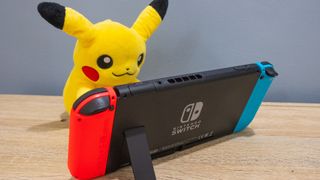
Ode to joysticks
I’m very fortunate in that as part of my job I have access to cutting-edge PC gaming technology. Not only do I have a powerful desktop PC with an RTX 3090, but I also built a brilliant compact gaming PC that is small enough to fit underneath my TV, yet can play AAA games better than the PS5 and Xbox Series X ever could.
It’s this PC that’s helped me really fall back in love with PC gaming. My main gaming PC is great, but during the Covid-19 pandemic, I’ve been working from home on that PC, and it’s meant at the end of the day, I don’t really want to then be sitting at that same desk.
The compact PC downstairs, though, is completely different. As I explained in my article detailing the trials and tribulations of building a small form factor PC, I’ve set it up with a user interface (Playnite) that allows me to launch all my games by just using a wireless gamepad.
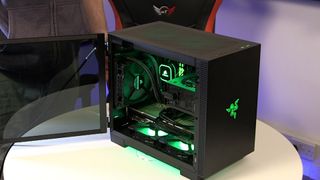
It means I can comfortably launch and play games from the comfort of my couch, using my 65-inch 4K TV as a monitor.
With no major Sony exclusives that I feel I’m missing out on (any Xbox game I’d want to play will be coming to PC as well), I’m able to play some of the best games out there… and Assassin’s Creed Valhalla.
I’ve played almost every mainline Assassin’s Creed game, and while I’m feeling increasingly burnt out by Ubisoft’s open world games, as soon as I heard I could be a Viking and stomp around my old drinking haunt of Winchester, I wanted to get it.
At first, I was going to play it on PS5, but having talked myself out of buying one, I got it on PC, and I’m glad I did. I’m able to play it at native 4K with graphical settings well above what the PS5 is capable of.
It’s not the best game ever (or even in the series), but I’m enjoying my time with it, and crucially, I’ve been able to play it without having to buy a next-gen console.
And if you look at the lists of the best games released this year, almost every one has come out on PC. Sometimes a game that’s a console exclusive on the Xbox Series X, PS5 or even Nintendo Switch, also comes out on PC. One of the best games I’ve played recently, Hades, was only available on consoles on the Switch. Although it’s now coming to more consoles, if I’d only owned an Xbox or PS5, I’d have missed out, but as I had a PC, I was able to play it there.

What about handheld gaming?
While my gaming PCs have been excellent alternatives to home consoles, what about handheld gaming? That was, after all, the biggest draw for the Nintendo Switch.
Well, there’s two great alternatives that have appeared that offer PC gaming in handheld form.
First of all, I got hold of a Razer Kishi gaming controller. This controller splits in two and lets you slip your smartphone (in my case a Samsung Galaxy Note 9) in the middle to act as a screen. It turns your smartphone into a very Switch-like device.
While it means playing mobile games on the smartphone is now more comfortable than using touch screen controls on some titles, what really blew me away was using it to stream PC games to my phone.
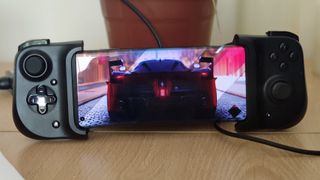
I first fired up the Xbox Games Pass app and played some GTA 5 on the phone, and, frankly, I was very impressed. At first I thought the service was a bit laggy, but then I remembered that GTA 5 just controls badly. Once I got back into the swing of things, the fact that I was playing a game as ambitious as GTA 5 on my phone was incredibly exciting. Granted, I was connected to my home Wi-Fi, but the experience was flawless, and the Razer Kishi made controlling the game feel as comfortable as if I was playing on a console.
Soon after I got the Razer Kishi, I was able to put it to good use when some Footballing tournament seemed to be on, and somehow my TV was being used to watch people kick a ball around a pitch. As you may have guessed, this did not interest me, so I connected the Razer Kishi to my phone, and this time tried the Nvidia GeForce Now app.
Logging into that showed a range of PC games that I already owned. To my delight, Assassin’s Creed Valhalla was sitting there, so after logging into my Ubisoft Connect account, I loaded it up. Rather brilliantly, once loaded I was plonked into the game in exactly the place I’d been on my PC. Again, the GeForce Now service ran brilliantly, and I was able to complete a number of missions using the Razer Kishi on my phone.
The next big test will be to see how it works when out and about. Will public Wi-Fi on trains and buses be enough to get a decent experience? I’m doubtful, but looking forward to giving it a go. I may even try getting hold of a 5G-enabled smartphone and seeing if that works. If it does, then I have a way to play PC games while commuting, and will have no need for a Nintendo Switch (though I’ll again be missing out on Nintendo exclusives).
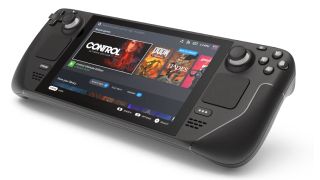
While the Razer Kishi and cloud streaming services is giving me an exciting alternative to the Switch, and allowing me to play PC games I already own on a mobile device, Valve also recently announced the Steam Deck. This is a handheld gaming PC that costs around the same as a Nintendo Switch, but is a lot more powerful.
As it’s a Valve device, Steam is heavily integrated, and that means I’d be able to access my large Steam library of games. It’s very early days for the Steam Deck, but this could be yet another PC gaming alternative for a handheld console. It would mean I wouldn’t have to rebuy games either, saving me money in the long run.
This once again makes me feel that sticking with PC gaming this gen is the right thing to do.
All about upgrades
For anyone who remembered my efforts making the small form factor gaming PC, I had built it around the RTX Titan that I already had. While this remains an excellent GPU, it wasn’t quite getting the performance I wanted out of modern games at 4K, with dips below 60FPS on the likes of Assassin’s Creed Valhalla.
So, when I had a chance to get my hands on an RTX 3080 Ti, I decided to swap the newer card in to see what performance increases (if any) I’d get. Being able to upgrade your gaming PC is one of the biggest benefits PC gaming has over console gaming, allowing it to keep on playing the latest games long after current generation consoles become obsolete.
As with anything to do with PCs, however, it’s not always straightforward. When I first built the PC, the only SF-sized PSU I could get my hands on was a 600W model from Corsair. While this was fine for the build as it was, the RTX 3080 Ti is a thirsty boi, so a 600W PSU wouldn’t cut it.
That meant I couldn’t just take out the old GPU and put in the new one. I’d have to replace the PSU as well. That can be a bit of a nightmare, as the PSU is cabled up all sorts of components usually. However, my decision to go with a modular PSU with the Corsair SF600 paid off, as I was able to get a Corsair SF750, which as the name suggests is a similar model, but with a rating of 750W, which is what I needed. Because that is also modular, it meant all I needed to do was unplug the cables from the PSU (rather than having to unplug from every component), remove the existing PSU, install the new PSU then plug the cables all back in.
So, while upgrading the PSU could have been a bit of a nightmare, it was actually quite straightforward. I was then able to swap out the GPU for the RTX 3080 Ti, then fire the PC up. I tested a range of games, including Assassin’s Creed Valhalla, and saw jumps of around 10 fps on average. While not huge it was enough for me to now play games at full graphical settings and at 4K without once dropping below 60 fps, which is exactly what I was after.
Definitely a worthwhile upgrade then, and a testament to how good the RTX 3080 Ti is, considering it’s half the price of the RTX Titan.
There is, of course, a big issue with PC gaming that still plagues us: a shortage of components. While picking up a CPU is easier, getting a new GPU remains incredibly difficult, and that really has taken the sheen of building or upgrading a gaming PC recently.
Hopefully stock shortages get sorted out sooner rather than later, and people will be able to complete their builds. I am under no illusion about how lucky I am.
Still, this has all cemented the feeling that I certainly don’t need a PS5 of Nintendo Switch OLED any time soon – PC gaming is giving me everything I need right now. Long may that continue.
- These are the best gaming laptops

Matt is TechRadar's Managing Editor for Core Tech, looking after computing and mobile technology. Having written for a number of publications such as PC Plus, PC Format, T3 and Linux Format, there's no aspect of technology that Matt isn't passionate about, especially computing and PC gaming. He’s personally reviewed and used most of the laptops in our best laptops guide - and since joining TechRadar in 2014, he's reviewed over 250 laptops and computing accessories personally.